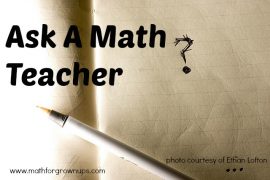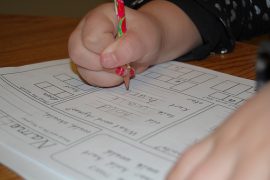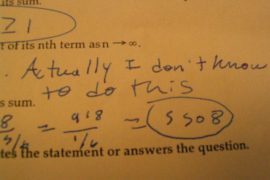Welcome to the first edition of Ask a Math Teacher, which will feature real, live math questions from real, live people. How often will I do this? As often as I can. What kinds of questions can you expect? Whatever people ask. If you have a question, please post it to the Math for Grownups Facebookpage (after clicking “like” of course!) or email me at lelaing-at-gmail-com.
Today’s question comes from my friend and cookbook author, Debbie Koenig. You really should check out her blog and book, Parents Need to Eat Too. Debbie posted this question on Facebook, which led to a two-day long post-a-thon. We finally got to the root of the question — and answer — and I thought you would like to hear about it.
My son’s math homework has me scratching my head–he’s supposed to “Draw a picture of 600 hundreds” in a space that’s maybe an inch and a half high. How does one draw 600 of anything in that small a space? And why is he drawing 600 of something? I have no idea how to help him.
One thing that isn’t clear in this question is that her son is in second grade. This is a really important piece of information, because the answer is going to seem completely counter-intuitive to us grownups.
Some background: When children learn their numbers and then learn to count and then learn to write 3s, 7s and 4s (sometimes backwards), they are picking up teeny-tiny bits of number sense. When all of this information is put together, we call that numeracy. You can think of numeracy like literacy. It’s not just being able to count or add; it’s being able to understand how numbers work together in a much larger sense. As you can imagine, this is a big, hairy deal. It takes years and years to get to where we adults are. And most of us grownups take for granted the numeracy that we do have.
I say this because what this “hundreds” thing is getting at is place value, or the position of a digit in a number. Teachers can just tell students that the 4 in 9433 is in the tens place, or — and this is a muchbetter idea — students can learn a great deal more about numbers by really exploring this concept.
You see, place value is not some random construct. There are reasons that the first place to the right of a decimal is the ones place and the fourth place to the right of the decimal is the thousands place. Exploring this can help kids get better at multiplying or dividing and lay the foundation for decimals and even percentages.
So with that said, the first thing to do is ignore what you think hundreds means. Unless you’ve had some experience in math education, you’re probably not going to take the right guess. In second-grade math class, hundreds does not mean one hundred. It means the hundreds place.
The easiest way to get into this is by looking at a hundreds chart.
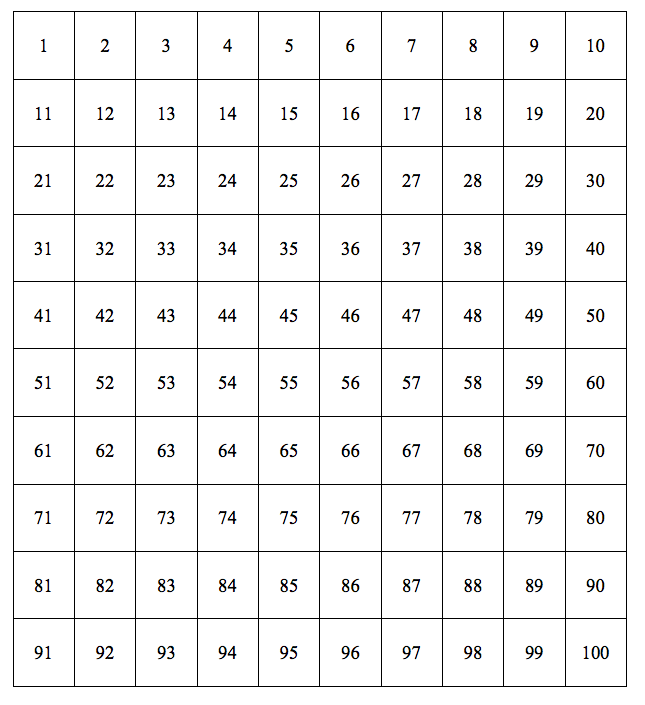
If you have one of these hundred charts, you have 100, right? How can you represent 600 then? I’ll give you a second to think about it…
Yep, with six of these buggers! Here’s a visual representation without the numbers:
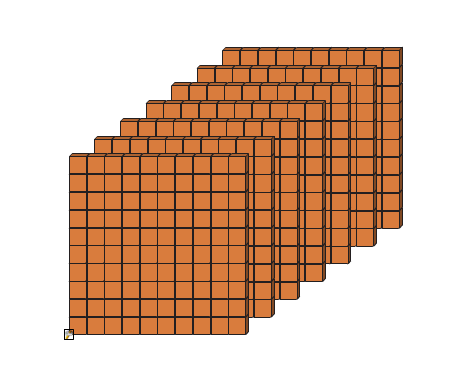
So what Debbie’s son was being asked to do was draw something like the above. It’s important because it has to do with place value. Only most second graders don’t have a clue about that stuff yet. And what they have learned so far sounds like a big mistake to the rest of us — because the language being used is not what we expect. He’ll learn the word “place value” in due time and forget about these hundreds tiles and charts and suchlike.
Asking students to draw “600 hundreds” is helping students visualize place value and other important concepts. Teachers call these manipulatives, especially because they’re often real objects that students can pick up and move around. But on a homework worksheet, they’re a little harder to translate, especially for a parent who went to elementary school more than a few years ago.
So that’s the story of “hundreds,” at least as far as a second grader is concerned. I’d love to hear your thoughts! Do you know of other ways to get to the basics of place value? Do you, personally, think of place value differently? Share in the comments section.
P.S. I’m going to be speaking to parents of elementary-aged kids at my daughter’s school later this month. If you have questions that you think I should address, feel free to shoot me a quick note or post on the Math For Grownups Facebook Page. And if your school — in the D.C.-Baltimore area — would like to have me come down for a Math Chat, let me know. I’d love to meet you!
